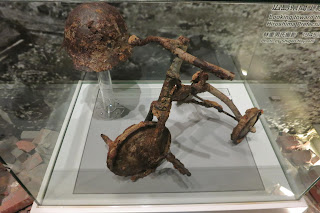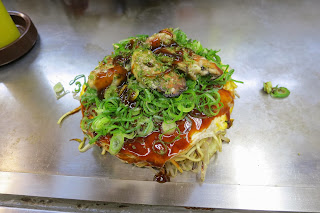As our travel book says, Hiroshima needs no introduction due to the worst of reasons. It was a very mixed emotion visit - being in the exact places where one of the most horrible world events occurred was sobering, but the way the city has re-invented itself into such a beautiful place, as well as keeping reminders for the world about the devastation that took place there was - in its own way - uplifting and hopeful.
To get there, we took the shinkansen (bullet train). It was a fun experience - you don't realize how fast you are going until you get up and try to walk around. The speed of each train is variable - the one we were on was going between 200-300 km/hr (~120-190 mph). Definitely a worthwhile experience for anyone visiting Japan, however it is quite expensive for tickets.
 |
| Shinkansen pulling into station |
On arrival, we were ready for lunch and started our trip off by eating oysters - one of Hiroshima's local specialties. Hiroshima is Japan's leading producer of oysters, cultivated in the Seto Inland Sea just outside the city. The restaurant we ate at even has its very own oyster farm. There, we had a 7 course oyster lunch which included oysters baked, fried, steamed, marinated and in soups. Very yummy. The decor was also great - on a boat, wait staff dressed in kimonos, taking your shoes off to enter dining room, etc.
Next, we crossed the river to head to Peace Park - where most of the memorials related to the bombing are located. The atomic bomb was dropped at 8:15am on August 6th, 1945 and killed tens of thousands of people instantly, and the death toll continued (and still continues) to rise to 180,000-200,000 people. At the forefront of the park is the A-Bomb Dome building. The building was built in 1915 by a European architect and had a bold European style in an otherwise crowded, work-oriented city with few modern touches. The explosion took place almost immediately above this building, which is why the walls remained mostly intact, but the dome shattered and all the people inside were killed immediately by the heat of the explosion. Upon the re-building of the city after the war, this building was left alone simply because it was more difficult to demolish than the other remains. It was then decided to leave the building untouched to remind people of the devastation of nuclear weapons, and has been declared a UNESCO World Heritage site.
The Peace Memorial Museum was perhaps the most difficult part of the memorial to get through. Similar in emotional response as to the Holocaust Museum. Well laid out history of the city of Hiroshima, the events leading up to the bombing and the long-reaching after effects. There were plenty of graphic reminders of the devastation - including many personal effects of victims and their families. Families have donated to the museum some of their only physical memories of their loved ones - burned school uniforms, fingernails, skin flakes, glass shards, etc., adding to the emotional experience this museum has. Below are some pictures from inside the museum.
 |
| The imprint of a person sitting on the steps when the bomb exploded |
 |
| Fused pottery from the heat of the explosion |
The Children's Peace Monument was erected in honor of a junior high school girl who died of cancer - a direct result of the radioactive aftermath of the bombings. She believed that if she made 1,000 paper cranes that she would recover from her illness. The statue depicts a girl with outstretched arms and folded paper crane rising above her. The crane is a Japanese symbol of longevity and happiness. School children and others send and bring thousands of paper cranes to the site every year.
 |
| The containers with all the paper cranes |
The Peace Bell is engraved with a world map, drawn without borders to symbolize unity. Everyone can ring the bell.
The Cenotaph for the A-Bomb Victims was built exactly 7 years after the bombing. Underneath the structure (the arch shape representing a shelter for the souls of the victims), is a chest which holds the names of all people who have died from the bombing and names are added as more continue to pass away from complications of the blast. There is an inscription in Japanese which reads "Let all the souls here rest in peace, for the evil shall not be repeated."
Inside the park are "Phoenix trees", which have scorch marks on the trunks. These trees were growing about 1 mile from the hypocenter and have been replanted in the park.
To close out the Peace Park portion of our Hiroshima tour, is a quote from the Peace Memorial Hall brochure - "Mourning the lives lost in the atomic bombing, we pledge to convey the truth of this tragedy throughout Japan and the world, pass it on to the future, learn the lessons of history, and build a peaceful world free from nuclear weapons."
Prior to the bombing, Hiroshima was developed as a castle town with Hiroshima Castle at the forefront - lived in by once the most powerful clan to rule the region. The castle was nicknamed "Carp Castle" since the area it was built on was called Koi-no-ura (Koi Sea Shore), and Koi in Japanese means carp. It seems fitting then that Hiroshima's baseball team is named The Carp. :) The castle was built originally in the 1590's, but completely destroyed in the bombing. It was rebuilt in 1958 and now houses historic artifacts.
 |
| Moat leading to castle grounds |
 |
| Ninja performers on the grounds |
 |
| View from top of castle |
 |
| Hiroshima City from top of castle |
Another one of Hiroshima's famous dishes is okonomiyaki. This literally means "cook it as you like", and consists of a pancake like shell topped with egg, cabbage, soba noodles, meat, seafood, cheese or all of the above. Okonomiyaki sauce tops it off. It is grilled in layers on a hot stove in front of you. It is literally a hot mess to eat, but soooo good. There are competing versions of okonomiyaki - the Hiroshima version, in which the ingredients are layered as it is cooked - and the Osaka version, in which the ingredients are mixed together first and then cooked. When we go to Osaka, we will have to try the other version, but the Hiroshima version will be hard to beat. We also got to watch the Carp play ball on TV (in the playoffs) and had some good baseball conversation with the cooks. We ate in a building that houses 27 different okonomiyaki shops - all with different variations and ingredients.
Lastly in Hiroshima, we went to Shukkeien Garden. This literally means "shrunken-scenery garden", as valleys, mountains and forests in miniature are meant to replicate a legendary lake in China. The garden dates back to 1620, and as with everything in Hiroshima was affected by the bombing. It served as a refuge for bombing and war victims. There are many tea houses throughout the garden to enjoy the beautiful views.
That's all from Hiroshima. I still have Miyajima Island to write about, but that will have to wait for another day. Until then - cheers! :)











































